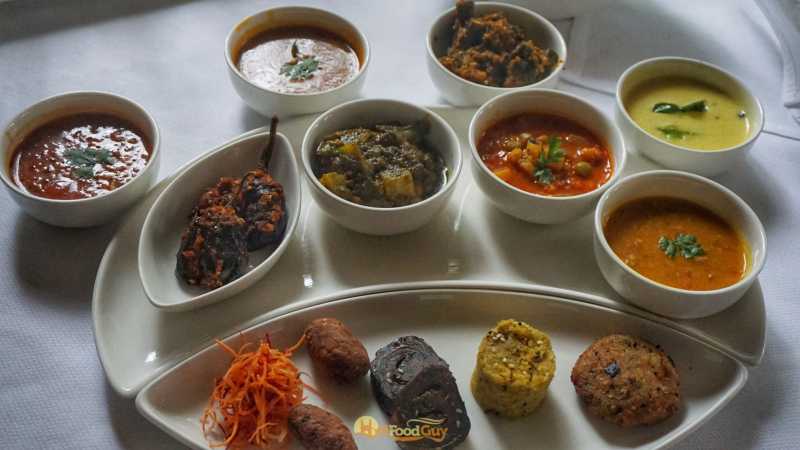Taj Krishna has partnered with Gujarat Tourism to create a Gujarati Food Festival that promises authentic, traditional Gujarati fare. While Dhokla and Dabeli and Gujarati savouries are popular around the country, other facets of this diverse cuisine remain little known. During the nine days of Navaratri, many Hindus turn strictly vegetarian, abandoning even onion in garlic. Hence, it’s an apt time to showcase Gujarati cuisine, which is almost entirely vegetarian.
I was invited to a tasting session at Firdaus, where I was presented with a lavish Gujarati Thali. Gujaratis love both savouries and sweet, and you can expect a traditional Thali to be loaded with both namkeen and mithai. We were presented with Fafda, Dhokla, Handvo, Petis, Methi na Muthiya, Patra, and Khandvi. The thali will feature only three of these, but a Farsaan platter is also available separately for those looking to indulge only in the savouries. All the dishes showcased can also be ordered individually from the a la carte menu. While each of the Farsaan were terrific, the Dhokla stood out. It was quite simply sensational – soft and spongy but not soggy. I’m a fan of Patra (spiced Colocasia Leaf Roll), Khandvi (sweet and tangy Gram Flour and Yoghurt rolls), and Handvo (steamed savoury cake). While the former two lived up to my expectations, the Handvo was a bit off kilter – bland and soggy.
The main course spread featured Surthi Undhiyu, Sev Tamatar, Bharwan Ringan, Gujarati Dal, and Kadhi-Khichdi. Undhiyu is one of my favourite Gujarati gravies. This winter favourite is a mish-mash of various seasonal greens and muthiya (fried dumplings). During my Gujarat trip earlier this year, I was surprised by how difficult it is to find Undhiyu in restaurants across Gujarat. It’s a seasonal delicacy that seems to be mostly restricted to households. I spotted Undhiyu at a couple of places, but both of them were the spicy Kathiayvadi variant. I was thrilled to spot the Surti Undhiyu on the thali. The Surti Undhiyu uses a milder masala that’s stuffed into the veggies. The Bharwan Ringan is Gujarati take on the stuffed aubergine that’s popular across the country. In this recipe, baby brinjals are stuffed with a sweet and spicy dry roasted masala and dried coconut powder. The chatpata Sev Tamatar with its lip-smacking combination of tang and spice is a staple in Gujarati buffets and plays the pivotal role of balancing otherwise many sweet elements on a Gujarati spread. The Gujarati Dal is famous (or infamous) for being sweet, but what I found during my Gujarat travel is that it’s not as saccharine as it’s often portrayed to be. However, the one served in Firdaus is loaded with sugar and lives up to the stereotypical portrayal. Accompanying the myriad of main courses were Bajra ka Rotla and Methi ka Thepla.
The dessert platter was comprised of Ormu, Doodhpak, and Mohanthal. Ormu or Lapsi is a ghee infused, broken wheat dessert that’s commonly prepared in Gujarati households during festivals. This was my first exposure to this dish and I found it to be a tad too dry and the grains weren’t as soft as I had expected them to be. However, the Doodh Pak (milk, rice, and saffron pudding) and Mohan Thal (dry fruits and besan barfi) were absolutely delicious.
The Gujarati Food Festival will continue at Firdaus until 30th September. The Thali is priced at Rs. 2500, while the Gujarati starters can be ordered separately for Rs. 1200 and only Farsan for Rs. 550 (all prices exclusive of taxes). Gujarat Tourism has flown in a couple of Maharaj (Chefs) from the state to ensure quality and authenticity. And the effort of the team at Taj Krishna and Gujarat Tourism proved to be quite successful. We were served a whole host of dishes, and baring a couple of exceptions, everything was delightful. Whether you’re a fan of Gujarati cuisine or you just want some delicious Satvik food, this is one food promotion that should be on your list.









